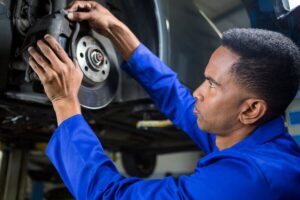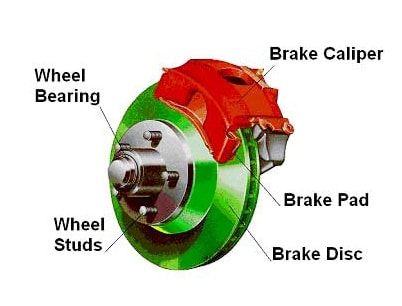
Brake safety starts long before something goes wrong. For drivers concerned about brake repair in Plainfield, knowing how to care for your system before problems arise is key. Brakes are one of the most critical safety features on your vehicle, and the wear and tear they endure daily makes regular attention a must. While repairs are inevitable with time, smart preventative care can drastically reduce the frequency and cost of those repairs. Whether you’re commuting through Plainfield traffic or heading out for a weekend drive, having responsive, well-maintained brakes is non-negotiable. Understanding when to check them, how they wear, and what impacts their performance can keep
Understanding Brake Pad Lifespan
your vehicle out of the shop longer. This guide walks you through important habits and knowledge every driver should have to avoid surprise brake repair Plainfield situations.
Brake pads wear down over time, and recognizing their lifespan helps prevent further damage to your braking system. On average, brake pads should be inspected every 10,000 to 15,000 miles, though this number may vary based on your driving habits and vehicle type. City driving with frequent stopping tends to wear pads faster than highway travel. Letting brake pads wear too thin can damage the rotors and calipers, leading to more costly repairs. Replacing brake pads before they reach dangerous levels preserves not only the vehicle’s safety but also your wallet. For drivers in Plainfield, regular brake inspections are especially important due to weather shifts and local driving conditions. Trusting a professional for routine checks ensures you’ll never be caught off guard by a brake warning light or squealing noise.
Driving Habits Matter
The way you drive plays a huge role in how long your brake pads last. Constant hard braking, tailgating, or rapid acceleration increases friction and heat, wearing pads prematurely. Practicing gradual stops, coasting, and maintaining a safe distance from other vehicles helps preserve your pads and improve overall brake performance.
Type of Brake Pads
Not all brake pads are created equal. Ceramic pads offer longevity and cleaner braking but cost more. Semi-metallic pads balance performance and price, while organic pads are quieter and softer but wear faster. Understanding your pad type helps set realistic expectations for maintenance intervals and budget-friendly replacements for your specific needs.
Vehicle Type and Load
Your vehicle’s size and the load it carries directly impact brake pad life. Heavier vehicles like trucks and vans apply more pressure to the brake system. Hauling equipment, passengers, or towing trailers adds stress, shortening pad lifespan. Choosing pads designed for your load and driving habits keeps your brakes reliable.
Environmental Conditions
Road and weather conditions matter more than most people realize. Uphill driving, constant braking on descents, or urban environments with traffic lights speed up pad wear. Dust, mud, and moisture increase grime buildup, while salted winter roads corrode brake components. Where you drive can significantly affect how often you need replacements.
Routine Inspections
Staying on top of routine brake inspections is one of the easiest ways to avoid costly repairs. During maintenance, technicians measure brake pad thickness and check for uneven wear. Catching issues early allows timely pad replacement, helping you avoid damage to rotors, calipers, and other expensive components in the braking system.
Monitoring Brake Fluid Condition
Brake fluid is a key component of your braking system. It transfers force into pressure, allowing your brakes to function properly. Over time, brake fluid can absorb moisture from the air, becoming less effective and potentially corroding internal brake parts. A murky, dark fluid is a clear sign it’s time for a flush. Brake fluid should be checked at least once a year or during every oil change. For Plainfield drivers, sudden temperature swings can affect moisture levels, increasing the risk of fluid degradation. Preventative maintenance includes topping off low fluid, using manufacturer-recommended types, and flushing the system at the suggested interval. Neglecting this step can compromise braking power, especially in emergencies. Maintaining healthy fluid levels is a small investment that prevents major brake repair Plainfield drivers often face.
Recognizing Unusual Brake Noises Early
Squeaks, grinding, or clunking noises are your car’s way of signaling that something’s off in the braking system. While occasional noise may be normal due to dust or morning condensation, persistent or loud sounds are often early signs of worn brake pads, warped rotors, or misaligned components. Addressing these sounds early can stop a minor issue from turning into a complete system failure. Plainfield roads with varying terrain and weather conditions can cause unique stress on your vehicle, making noise detection even more critical. Preventative care means listening closely and reacting promptly. The moment you hear irregular braking sounds, it’s time for a brake inspection. Avoiding these warnings may lead to sudden brake failure, reduced stopping power, and far more expensive brake repair Plainfield services down the line.
The Role of Tire Health in Brake Performance
Tires and brakes work together to bring your vehicle to a safe stop. Worn or underinflated tires reduce traction, causing the brakes to work harder and wear out faster. Uneven tire wear can also indicate alignment or suspension issues, which indirectly impact braking performance. For best results, rotate your tires regularly and ensure they’re properly inflated. This helps maintain even braking force across all wheels. In Plainfield’s diverse weather—from slick winter roads to dry summer heat—healthy tires are essential for safe stopping. When drivers neglect tire care, it puts unnecessary strain on the braking system, leading to premature wear and potential failure. Integrating tire checks into your preventative maintenance routine can reduce your chances of needing urgent brake repair in Plainfield and improve overall vehicle safety.
Keeping an Eye on Brake Light Indicators
Your vehicle’s brake warning light isn’t just for show—it’s a vital alert system. Whether it signals low fluid, worn pads, or a sensor issue, the light should never be ignored. Many drivers delay action, assuming it’s a false alarm or a minor problem. But that tiny light could be warning of a serious safety concern. In Plainfield, where you may face stop-and-go traffic or longer drives, responsive brakes are non-negotiable. When your brake light turns on, it’s a smart move to get a professional inspection immediately. Ignoring it risks sudden brake failure, especially if fluid levels are critically low or pad sensors are exposed. Preventative care includes knowing what each dashboard signal means and acting on it. This quick response helps avoid larger brake repair Plainfield expenses later.
Scheduling Routine Brake Inspections
Routine brake inspections are one of the smartest preventative moves any driver can make. A certified technician can spot early wear, fluid issues, or rotor damage long before they cause real trouble. For Plainfield residents who deal with seasonal driving challenges and high-traffic zones, regular inspections offer peace of mind and cost savings. During a checkup, mechanics assess pad thickness, fluid quality, rotor condition, and the general performance of the braking system. This detailed overview allows minor concerns to be addressed quickly, before they escalate into larger repair bills. A yearly inspection is usually enough for most drivers, but if you frequently brake hard or drive long distances, every six months is ideal. Avoiding unscheduled brake repair Plainfield emergencies starts with making inspections part of your annual maintenance plan.
Driving Habits That Extend Brake Life
The way you drive has a direct impact on how quickly your brakes wear down. Constant hard braking, riding the brakes downhill, or following too closely in traffic all increase the strain on your system. Gentle, gradual braking allows heat to dissipate and reduces friction on brake pads and rotors. In Plainfield, where sudden weather shifts and urban traffic are common, adapting your habits can go a long way. Try to anticipate stops in advance and coast to reduce the load on your brakes. This kind of preventative care not only keeps you safer but also saves you money. Smart drivers understand that small daily changes in driving behavior can significantly delay the need for brake repair Plainfield services and extend the life of their entire braking system.
Conclusion
Caring for your brakes doesn’t need to wait for an emergency. With smart preventative habits and regular inspections, you can avoid major issues and stay safe on the road. At Last Chance Auto Repair For Cars Trucks in Plainfield, we take your vehicle’s safety seriously. Our experienced team is here to help you catch brake problems early and fix them fast. Don’t let minor wear turn into major repairs—schedule your inspection today. Your brakes are essential, and so is our expert care. Call now or visit us for trusted service in Plainfield.


